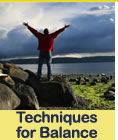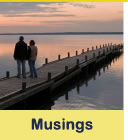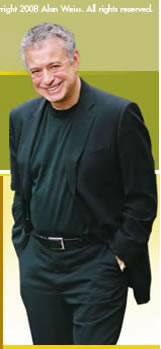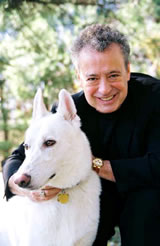    
If the images are not perfect, click "download pictures" on your email and they will be displayed as intended. Balancing Act: The Newsletter (No. 110: October 2008) NOTE: Maria and I sailed the North Atlantic in the largest suite on the Queen Mary 2 in September. This issue was written on board. 
Techniques for balance when in new surroundings

Into the unknown I remember seeing photos of the Wright Brothers demonstrating their new flying machine by circling the Statue of Liberty. They were not considering failure or defeat, since there were no parachutes, no redundant systems. When you are in the middle of the Atlantic, with an unending horizon, you tend to become stunned by brave people who put themselves in harm's way in sailing ships. Most 17th and 18th Century sailors couldn't swim, not that it mattered, because rescue from shipwreck, combat, or accident was exceedingly rare. Traveling farther back, it's almost inconceivable to try to imagine what the early Vikings and Chinese seafarers could have felt without any navigation help except the heavens, instinct, and luck. Columbus's huge discovery was the result of a mammoth navigational and geographic error. These were fragile ships carrying the bare minimum for an uncomfortable existence. John Glenn's orbit in space, or Neil Armstrong's walk on the moon, were accompanied by unprecedented resources and support. (Apollo 13 survived a devastating accident to return safely). What are you hesitating about? Taking a new job? Moving? Changing a relationship? Learning a new skill? Pursuing a new sport or hobby? Making an investment? Changing a regimen? We seem to feel that we are alone, and leaping over a huge chasm, when in reality, we are surrounded by support and succor, and we're merely adjusting our stride. I understand people who have fish allergies, but not people who simply refuse to eat fish. I understand the reluctance of people with a speech impediment to speak publicly (though many do and quite well), but not those who are simply "afraid" of the audience. I understand people who are uncomfortable expressing themselves in a language they haven't mastered, but not those who refuse to try. Most of our "unknowns" are actually known quite well. Someone has been there before. The light is on, the track is clear, the safety net in place. If you don't want to leap into the dark, fair enough. Open your eyes. 
The first realization is that the ship is a living entity. The steel and wood and glass which comprise its corporeal existence are merely the exoskeleton. The systolic pulse of the engines is omnipresent, no matter where you are, fore or aft, topside or below. The ship beats with life. One thinks of the vessel sliding through the pitch black night like a paper cut, sleek and elegant, momentarily stinging the ocean. But it is a much more quotidian journey. The ship is more like a mature horse, plowing through the waters. In the daylight you can look astern and see the wake for a half-mile, the furrow we've created in the field. It is a different color from the surrounding water, lighter and greener, as if new earth had been tilled. The voyage is referred to as a "crossing," a feat that one accomplishes, more durable and memorable than a "trip" or a "cruise." The crew heightens the singularity of the experience. The Commodore (senior captain of the Cunard lines, carefully pronounced "cue-nard") addresses us all daily to apprise us of conditions, ocean depth, and what is too far away to be seen to the north and south, clearly implying that we can't begin to appreciate the vastness of this world. He holds a reception but only for the highest class of service, and one says "hello" but is not expected to chat. Some people look at the 360° horizon and feel that they are insignificant, mere dots on the huge surface. I feel otherwise, actually larger than life. After all, my colleagues have been able to create this ship and this passage, this crossing, despite the formidable barriers of distance and depth. I feel exalted to be here, mastering the sea through the mastery of others. Throughout the ages we have been enchanted with the notion of a time machine, a transport to our past and future. The past is well known, but imperfectly, since photos, movies, and recordings can evoke but not involve. But on the great ship we are transported back to the 1930s, to men in tuxedos and women in gowns, to big bands and formal dancing, to elegant gambling and fine dining. We gallivant through the night, in the darkness, traveling through time as well. Right up to the sixth and final night, we are in the ether of the early Twentieth Century, breathing bracing fresh air, watching a million stars' light from light years ago, moving amongst free spirits. We awake on the final morning in Southampton, no longer at sea, the sun rising to reveal modern times. The ship is finally silent, its life suspended, supported by the umbilical chords and clamps connected to the dock. The past, as always, is somewhere behind us, but this time just off the stern, there in the darkness, I was there. 
I called the butler to our suite on the Queen Mary to tie my tuxedo bow tie, since I've never mastered the trait. My wife kept rolling her eyes, but the ceremony was completed in about 10 minutes. "There," the butler announced. As he helped me with my jacket and I turned to leave, he shouted "Wait!" He whipped out a de-linter. The back of my jacket was covered with white German Shepherd hairs. NOTE: For those of you not following my blog, our daughter gave birth to twin girls three months prematurely, and Maria and I rushed home from Europe. Everyone is doing well, though each day is a new victory for the girls. They will be 2.5 weeks old as you read this. All prayers are welcome and appreciated. Please don't call or write, it will complicate our lives. But we'll know you're helping. You may leave a comment at the twins' blog: Thanks Alan |

Balancing Act® is our registered trademark. You are encouraged to share the contents with others with appropriate attribution. Please use the ® whenever the phrase "Balancing Act" is used in connection with this newsletter or our workshops. The StrategistSydney, Australia, October 8-9
|
|
Having problems viewing this email, click here.
|
|








